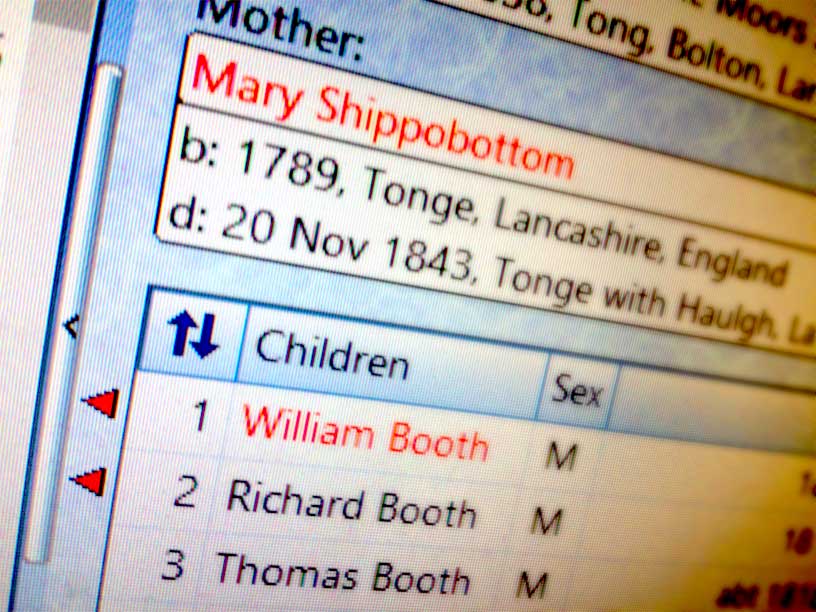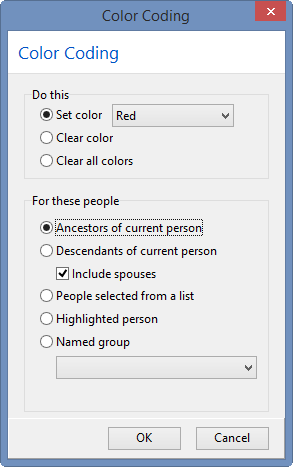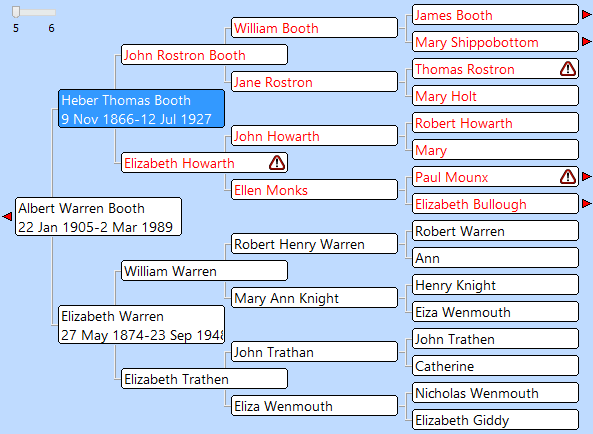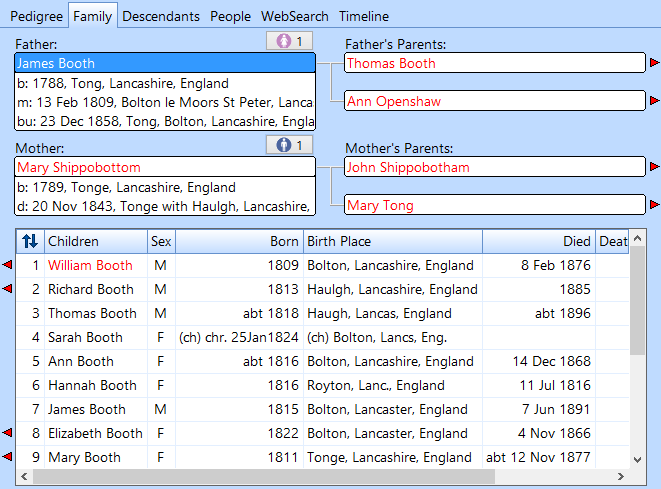Have you ever started exploring around your family tree and found yourself lost, unsure which line to follow to get back down to your more recent ancestors? The Color Coding feature in RootsMagic makes it easy to leave yourself “breadcrumbs” so that you always know which people are your direct-line ancestors.
The first thing to do is to find yourself on the RootsMagic main screen. Once you’re selected yourself, choose Tools > Color Code People from the main menu. You’ll see this screen:
Choose whichever color you like from the Set color box (I prefer something that really stands out). Select Ancestors of current person and then click OK. You’ll now see that all the ancestors of the selected person will appear in the selected color, whether on the main screen or in various reports and charts.
Now if you ever get lost in the upper-branches of your tree, just click on the Family view and look at the list of children:
Whichever child is marked in your selected color is a direct-line ancestor. Just click on the arrow to the left of the name to climb down the tree until you reach familiar territory.
Of course, this is just one possible use for Color Coding. Not only can you color lines of ancestors and descendants, but you can also color people based on endless criteria such as where they were born, if they are missing information, if they are the end-of-the-line, etc. You can use up to 14 different colors, each with a different meaning of your own choosing.
To learn more about Color Coding, be sure to watch our short video demonstrating it:




I really enjoy using this feature. It is very useful when working on distant ancestors and you come across some possible links to the siblings of your direct ancestor. Thank you for including this helpful tool. Now if you could only get the names to flash of those that have new information to be added.
I used the color coding feature and it helps me keep track of families. I color coded my grandparents on both sides of the family; although, I wish there were more darker color shades. For example, I have two shades of blue, one is a Navy blue and that’s not a problem; but, the other blue is a real light blue and I have problems at times with it. Same way with some of the greens. I’ll try a different color to see if it will help.
I just LOVE color coding. My suggestion: I don’t color code starting with myself. I color-code based on my grandparents – blue for my paternal grandfather, purple for paternal grandmother, red for maternal grandfather, pink for maternal grandmother. In this way, I can find my way back to myself, but can also tell from what line it comes.
This is so great…. I love it
I use it all the time, and it works GREAT! But with over 17000 in my data base I still occasionally get lost!!!.
Great presentation on color coding. I have enjoyed using this feature in the past especially with my ancestral lines that use patronymic naming patterns. Thank you for sharing this instruction in such a brief yet informative way. I have learned how to use this feature more effectively. One question though. Do you have to reset the color when you add more individuals to a particular family ancestral line?
Reply: Yes, you will need to redo the color-coding when you add more people to your ancestral line. It will not automatically update based on your earlier criteria for color-coding.
Renee, RootsMagic
Informative and clear
When I start working in a county, I usually trace everybody with the same last name. For example, I’m looking for eight children for a lady name Hiley Murphy in Union County, Illinois. I’ve got proof of two people being her descendants and I’ve got all of the people in these two lines color coded blue. In another case, I know the family is not part of my Murphy line and they are color coded red. I don’t research the red line but as I happen upon records, I have the information and I can eliminate as possibly related to my Murphy interests. Color coding is handy and helpful.
I’ve had my direct lines color coded for some time. BUT – I never thought to color code based on other key facts. I have a datafile “unidentified” of people with the same surname as my line(s), but have not been able to tie them in. I think it would be helpful to color code based on their county, so I can see at a glance which folks link with which county, and thus may be able to better identify possible family groups. Thanks for the tip.
I’ve been using this feature for some time and find it very handy. It’s saved me a lot of time and trouble.
I love the color coding option! It helps me keep track of where I am when scouting through my pedigree. Thank you for making RootsMagic such a wonderful, useful tool for the family historian.
I use color coding to tell me about the temple work for each person, i.e. :
LIME – Ready for ordinance (lime shows up better than green)
BLUE – Ordinances performed
RED – Needs attention before ordinances can be done.
PURPLE – End of line in my data base.
FUSHIA – Reserved
MAROON – In Progress
I hope this helps someone!!
I have used the color coding for a while now. Each branch of my tree is a different color. I take it one step further and use the same color file folder for the papers that I save about them. All I have to do is find the person in my RM files and see what color our mutual relative is and that is the color of file folder I use.
This is a great feature of Rootsmagic. I have used it for a long time and love it. A great time savor.
I have used the color coding for a long time.. I love it!
I use colors only for my direct ancestors as suggested in this article. I vary the color, however, based on the strength of my evidence. I use green for those ancestors for whom I have strong evidence, blue for those with good evidence, and red for those for whom the evidence is not yet strong.
The more I use the color coding, the more I want to use the color coding. It is so very effective when using, like Marilyn explained, to show the status of people in some project.
Very well presented!
George,
One of my rainy day projects is to do precisely what you have suggested, that is colour code entries by degree of certainty of the evidence available.
I assume once that format is used then the family colour is overwritten, is that correct? I think I will probably copy the entire database and have a spare copy just for the degree of certainty coloured information.
I concur also with Lee Martin more darker shades of the same colours would be immensely helpful.
Any suggestions would be welcome.
Reply: Yes, you can only have one color for a person at a time. If a new criteria is applied that effects someone already color-coded then it will over-write the color used previously. We are confirming that darker colors and bolding are enhancement request in on our development list for consideration.
Renee, RootsMagic
I’m happy that you included color coding in your program. I was already using it with my paper work and it was a
a great help. I’m very happy that I can continue including it. One suggestion: some of the light colors are very light, and they are hard to see, eg. yellow. However, I have made it work with another darker color. This feature is very helpful.
Thank heavens for Color Coding! I just wish there were more colors. One if my grandmothers lines intermarry and cross each other so often that I need 8 colors just to keep them all straight. Could you add a box so that we could have more colors? I love ROOTS MAGIC!
I use color coding to keep track of those people for whom I have verified information. If they are OK they get one color, If they need additional work and I need to come back to them, I code them another color.
As an Australian, I have found colour coding useful to keep track of who is the first migrator in each line. Choose a colour to show only the person who first arrived here; it gives me guidance on where I have to search – Australia or elsewhere. It also proves useful in checking whether they are in my line, or a related one, or even an unrelated one.
It helped me identify 6 cousins who all migrated around the same time.
It is interesting to see how others use the colors. I have all of my direct ancestors colored, but I have also color coded everyone who served in the military and immigrants in my tree.
Color coding people who never married has been very helpful for me. I have used this method since there is not a flag to indicate that a particular person never married.
would be nice to have what i will cal sex coloring what i mean for a family it would color code boys blue girls pink for a family
TyI haven’t used color coding before, but I can see where it can be very helpful. I am going to use it and see just how useful it can be, Thanks for this program, I use the program exclusively for my genealogy.
I LOVE color coding! Agree with the person who wants MORE COLORS. I like to color a paternal line a dark color (say green) and then the maternal line a lighter shade of the same color. Working with 8 surname lines (hubby’s lines and mine) I do NOT have enough color choices in RM. Also would like the colors darker (like being able to bold them) show they show better on the screens. SO VERY GLAD you offer these videos!!!!!!
Reply: Confirming the enhancements mentioned are in our development tracking system for future consideration.
Renee, RootsMagic
I use color coding to save time researching. In the Family Screen, siblings that had died as infants, or children (under age 18)and those that died unmarried without children are color coded gray or brown. That way, when I see a name without a spouse or descendants I know at a glance why their line ends (especially if they are missing either their birth or death dates).
I love the color coding feature. I use it to highlight those for which I have seen and verified an original birth document (blue). I use a similar color (purple) to indicate I’ve seen a transcribed version of the original document. This helps me in so many ways, especially when families are naming children similarly, or when there are two or more children in the same family with the same name (due to death of the older child).
I use colour coding for direct relatives,and then a different one for those I have to check info at the library. I use ancestry.co.uk at the library and other sources at home, and I find it quicker to look down the colours than search through the todo list. Only comment, is it too easy to accidently remove all colours.. and then I have to do them again
A super feature! Now I won’t get so lost in amongst the cousins and brothers and sisters. Also I can really see of all the names that come up increasing at the power of two at each successive generation, it will be a boon on those eye-tiring late nights organizing in pedigrees and families to quickly spot who belongs to the different direct lines on chart and list!!
Michael, thanks for the excellent information and for getting me thinking about this subject. I have decided to color code by country of origin. Between my wife and myself we have ancestors from most of the countries of Europe. I wish I could use stripes for an immigrant ancestor.
Now all I have to do is pick colors which might be difficult.